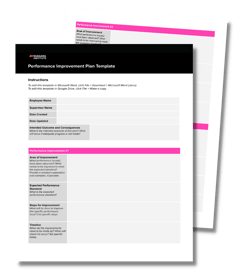5 min read
A Manager’s Perspective on the Performance Management Cycle
The term performance management may bring a shiver down your spine, as it did mine when I first started in management. Many managers, myself...
3 min read
 Michelle Bennett
:
Aug 24, 2023 5:00:00 AM
Michelle Bennett
:
Aug 24, 2023 5:00:00 AM

When an individual’s performance at work isn’t up to expectation, it negatively affects not only them but their teammates, their internal and external customers, and you, their leader, as well. As such, it is your responsibility to initiate a difficult conversation about what you’re witnessing, outlining the issues and the impact these issues are having, and then utilizing the appropriate performance management tools to correct them.
One popular tool many leaders rely on in this type of situation is a performance improvement plan. The following article will review what this is and why it’s important before providing you with a performance improvement plan template. Let’s begin.
By definition, a performance improvement plan is a formal document created for individuals who are not meeting agreed-upon performance standards in one or more areas of their role. The document should explicitly state the specific performance issue(s), steps for improvement, and a timeline with pre-determined checkpoints. It should be collaboratively written by an individual and their direct supervisor, though HR may sometimes be involved in the process.
Gone are the days when performance management was regimented and clinical. Today’s workforce isn’t okay with waiting months to connect with their leader and find out where they stand regarding their performance. They value their professional development and growth for that to be acceptable. Today, a more holistic, human, organic, and collaborative approach to performance and progress at work is the goal.
So, despite all the changes that have and continue to happen in performance management, performance improvement plans are still necessary. In fact, when used correctly, these plans help guide performance-related conversations and make a challenging topic more manageable to all parties involved. Moreover, the process of writing a performance improvement plan together can open up the doors for coaching, strengthen relationships, and build trust.
For a performance improvement plan to actually result in improved performance, it needs to be specific and detailed so that there is no question about what is expected. Therefore, to ensure no critical details are omitted, here are the elements to include in a performance improvement plan:

Whether you have never had to write a performance improvement plan or do not have a template to work off of, it can be challenging to know exactly where to start. Fortunately, we’ve removed that barrier by creating a performance improvement plan template for you to work off of and make your own in Google Docs or Microsoft Word.
Now that you have a performance improvement plan template, here are a few tips to keep in mind when you’re ready to begin filling it in.
Before writing a performance improvement plan, a direct leader should have an informal conversation with an individual regarding their concerns about their poor performance. That way, if the situation gets to the point where formal documentation is needed, the individual already has an idea of the problems and is not entirely caught off guard. If that happens, people can become defensive and less coachable, which makes writing a performance improvement plan more difficult than it already is.
The process of writing a performance improvement plan doesn’t have to feel like punishment. After all, it is a warning meant to bring attention to a problem, facilitate change, and make it clear that it is fixable, so long as the individual is willing to do the necessary work.
Rather than telling an individual about their performance issues and sending them off to write an improvement plan alone, make it a collaborative effort. By writing it with them, you can provide invaluable coaching and feedback. Not to mention, when people feel like they’re part of crafting the solution to a problem, they feel more accountable for seeing it through.

5 min read
The term performance management may bring a shiver down your spine, as it did mine when I first started in management. Many managers, myself...

4 min read
A performance conversation, which you may also hear referred to as a performance discussion or dialogue, happens between an employee and their direct...
.png)
6 min read
There is no one-size-fits-all when it comes to performance reviews. What works for one team or organization may not work for another. For example,...